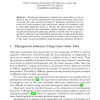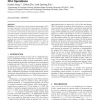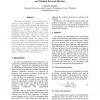36 search results - page 2 / 8 » Gene Maps Linearization Using Genomic Rearrangement Distance... |
RECOMB
2010
Springer
13 years 3 months ago
2010
Springer
Background: Genomic rearrangements have been studied since the beginnings of modern genetics and models for such rearrangements have been the subject of many papers over the last ...
BMCBI
2010
13 years 5 months ago
2010
Background: The rapidly increasing availability of whole-genome sequences has enabled the study of whole-genome evolution. Evolutionary mechanisms based on genome rearrangements h...
CPM
2000
Springer
13 years 8 months ago
2000
Springer
Breakpoint phylogenies methods have been shown to be an effective way to extract phylogenetic information from gene order data. Currently, the only practical breakpoint phylogeny a...
BIOINFORMATICS
2011
13 years 7 days ago
2011
Motivation: The double cut and join operation (abbreviated as DCJ) has been extensively used for genomic rearrangement. Although the DCJ distance between signed genomes with both ...
CSB
2005
IEEE
13 years 11 months ago
2005
IEEE
Traditional phylogenetic tree reconstruction is based on point mutations of a single gene. This approach is hardly suitable for genomes whose genes are almost identical and hardly...




